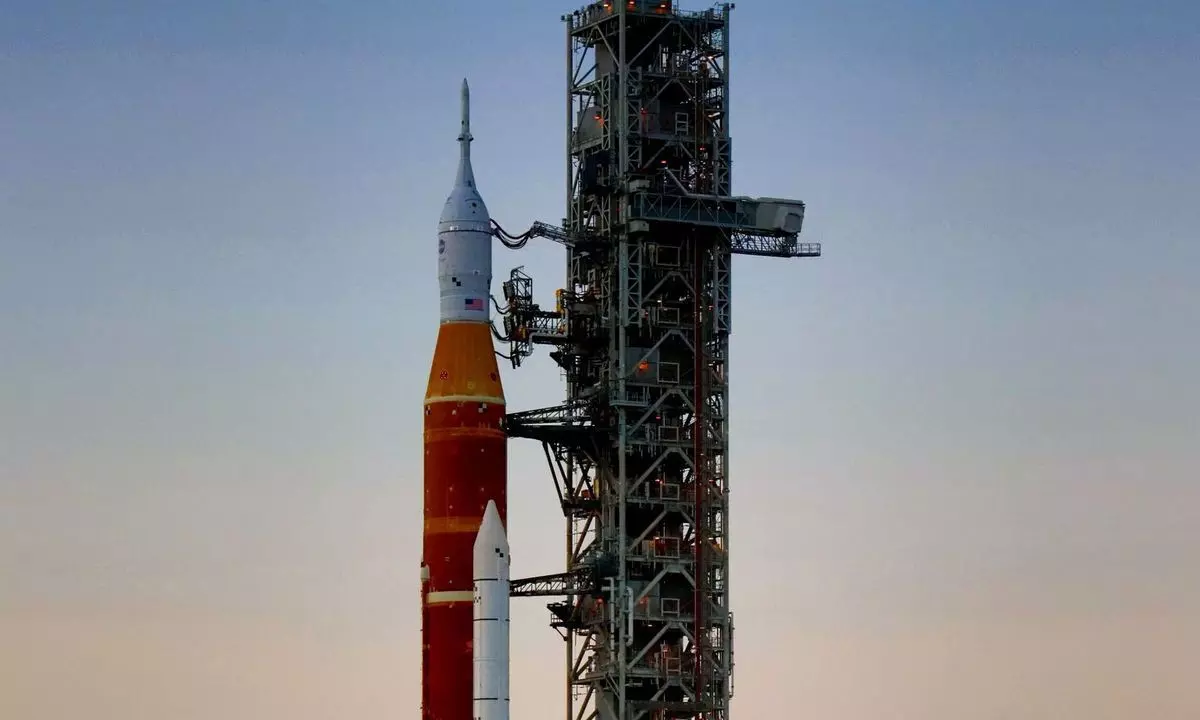Live
- All you need to know about PAN 2.0
- Akasa Air redefines travel experience with industry-first offerings
- MP: Residents stage protests against liquor shop in Indore
- Telugu Actor Shri Tej Booked for Alleged Cheating and False Promise of Marriage in Live-in Relationship
- Toyota Kirloskar Motor Celebrates 1 Lakh Urban Cruiser Hyryder on Indian Road
- MLS: New York City FC part ways with head coach Nick Cushing
- Delhi CM says Centre cutting AAP voters’ names from rolls, BJP hits back
- Hyderabad Metro Rail Phase-II Works to Begin in Old City in January 2025
- Odisha: 668 persons killed in human-elephant conflicts in last three years
- DEFENDER JOURNEYS: TO EMBARK ON ITS THIRD EDITION FROM NOVEMBER 2024
Just In
Countdown to NASA lunar mission put on hold


Countdown to NASA lunar mission put on hold
Leaks & cracks delay launch of moon rocket Artemis 1
Cape Canaveral: An engine problem threatened to delay the launch on Monday of NASA's most powerful rocket yet on an un-crewed test-flight to take humans back to the Moon and eventually to Mars.
The countdown clock has been put on hold at T-40 minutes. The hydrogen team will discuss the plans with Artemis 1 launch director.
Fifty years after astronauts last set foot on the moon during the Apollo 17 mission, the Artemis space program is to get underway with the launch of the un-crewed 322-foot (98-meter) Space Launch System (SLS) rocket at 8:33 am (1233 GMT) from the Kennedy Space Center in Florida.
Tens of thousands of people -- including US Vice President Kamala Harris -- are expected to gather along the beach to watch the launch, which has been decades in the making.
The goal of the flight, dubbed Artemis 1, is to test the SLS and the Orion crew capsule that sits atop the rocket.
Overnight operations to fill the rocket with more than three million litres of ultra-cold liquid hydrogen and oxygen were briefly delayed by a high risk of lightning, though it was a "go" after an hour.
Around 03:00 am, another hiccup emerged: a potential leak was detected during the filling of the main stage with hydrogen, causing a pause.
After tests, the flow resumed.
"The leak is at an acceptable level and we have returned to fast fill operations," NASA's Exploration Ground Systems tweeted, adding that they would continue monitoring.
While liftoff is scheduled for 8:33 am, there is a two-hour window during which NASA has said there is an 80 percent chance of acceptable weather.
After the slight delays during fuelling operations, NASA said it will determine a new launch time within that window. The massive orange-and-white rocket, which has been sitting on the space center's Launch Complex 39B for more than a week, will not be able to take off in case of rains and storms. The rocket's Orion capsule is set to orbit the Moon to see if the vessel is safe for people in the near future. At some point, Artemis aims to put a woman and a person of colour on the Moon for the first time. "This mission goes with a lot of hopes and dreams of a lot of people. And we now are the Artemis generation," NASA Administrator Bill Nelson said on Saturday. In another first, a woman -- Charlie Blackwell-Thompson -- will give the final green light for liftoff. Women now account for 30 percent of the control room staff, compared to one for the Apollo 11 mission -- the first-time astronauts landed on the moon in 1969. During the 42-day trip, the Orion capsule will orbit the Moon, coming within 60 miles (100 km) at its closest approach, and then fire its engines to shoot out 40,000 miles -- a record for a spacecraft rated to carry humans. Besides the weather, any technical snafu could delay liftoff at the last minute, NASA officials have said, stressing that this is a test flight. If the rocket is unable to take off Monday, September 2 and 5 have been pencilled in as alternative flight dates. One of the primary objectives of the mission is to test the capsule's heat shield, which at 16 feet in diameter is the largest ever built.
On its return to the Earth's atmosphere, the heat shield will have to withstand a speed of 25,000 miles per hour and a temperature of 5,000 degrees Fahrenheit (2,760 degrees Celsius) -- or half as hot as the Sun.
Dummies fitted with sensors will take the place of real crew members, recording acceleration, vibration and radiation levels.
The craft will deploy small satellites to study the lunar surface.
A complete failure would be devastating for a program costing $4.1 billion per launch and that is already years behind schedule.
Monday's launch is "not a near-term sprint, but a long-term marathon to bring the solar system and beyond into our sphere," said Bhavya Lal, NASA associate administrator for technology, policy and strategy. The next mission, Artemis 2, will take astronauts into orbit around the Moon without landing on its surface. The crew of Artemis 3 is to land on the Moon in 2025 at the earliest.

© 2024 Hyderabad Media House Limited/The Hans India. All rights reserved. Powered by hocalwire.com






